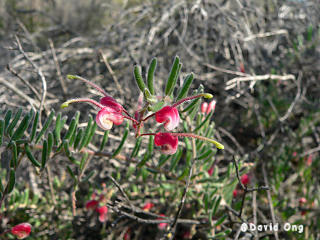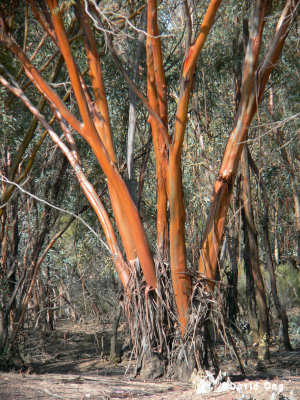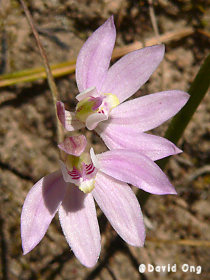Whipstick
The Kamarooka & Whipstick State Forest
The former Whipstick National Park lies north of Eaglehawk. There are numerous methods to reach it, either via Eaglehawk via Pyramid Hill Road/Raywood Road, or by turning left (west), off the Midland Highway at Epsom (near Bendigo Pottery) and then right onto Neilborough Road to Woodvale and stop at Shadbolt's Picnic Area.
Walking in the Whipstick National Park Forest at Woodvale is both very popular, exhilarating, and educational. There are many popular walking tracks and routes through the forest, which allow visitors a wonderful vista of natural fauna and wildlife in a restful setting.
In spring, it is worth walking the Old Tom's Mine Circuit for, if there have been good winter rains, the wildflower display is sensational. The southern section of this walk is through ironbark forest, a threatened ecosystem. 85% of Australia's original ironbark forests have been lost to clearing and the Whipstick is one of the few parks which protect this forest type.
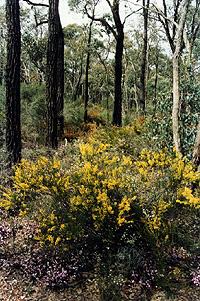
Spring wildflowers growing under Ironbark in the Whipstick
The circuit walk from Shadbolt's up Whipstick (Flagstaff) Hill is also worth doing. This is a good walk for observing mallee eucalypts.
The nature walk at Notley Picnic area is excellent because the different species of eucalypt are clearly labelled. Camping is allowed at Notley Picnic area. If you intend walking in the Whipstick Forest, the following map is recommended: Epsom 7724-1-3 1:25,000 (VicMap).
There is also a long walking trail from Mulga Dam at the northern end of Kamarooka forest across Campbell Road to Black Rock Flat. The route is marked with arrows on posts. There is an interesting rock formation near the end/start of the walk and close to Black Rock Road. The walk is best done in late August or early September when the Whirrakee Wattle is in bloom. A car shuttle is suggested. The walk includes Kamarooka Hill. The Summerfield 1:25,000 map (VicMap) is recommended; some crucial markers are, unfortunately, missing.
One spot worth visiting for spring wildflowers is Rifle Range Road (south of Notley Picnic Ground). Birdos may be interested to note that this area is reputed to have the greatest concentration of song birds in Australia.
Whipstick Plants
Many outstanding plants grow in the Bendigo Whipstick, Dargile State Forest and other areas of box-ironbark forest. Many are available for sale from Goldfields Regeneration Nursery, Bendigo. Some take the plants of these "forgotten forests" for granted but in few places are there more attractive wildflowers! Unfortunately, prolonged drought has had an adverse affect on the spring wildflower displays.
Here are just a few of the outstanding plants which grow in the forests around Bendigo and which are suitable for cultivation:
• Black-eyed Susan (Pink Bells) Tetratheca ciliate (Height: 0.3m)
• Cranberry Heath Astroloma humifusum (0.2m)
• Rosy Heath Myrtle (New genus name) ramosissima (0.3m.)
• Red Correa Correa reflexa rubra (1m.)
• Fairy Wax Flower Eriostemon verrucosus (1m.)
• Cat's Claws Grevillea alpina (1m)
Cat's Claw Spider Flower (Grevillea alpina)
• Wilson's Honey Myrtle Melaleuca wilsonii (2m.)
• Scarlet Mint Bush Prostanthera aspalathoides (2m.)
• Bent-leaf Wattle Acacia flexifolia (2m)
• Whirrakee Wattle Acacia williamsonii (3m.)
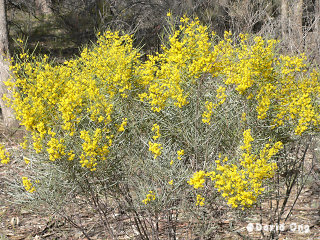
Whirrakee Wattle
• Green Mallee Eucalyptus viridis (5m)
• Bull Mallee Eucalyptus
Bull Mallee
• Caledenia are tiny orchid-like plants are best grown in pots. They are unlikely to survive if taken from the wild (which is illegal any way).
Caledonia
